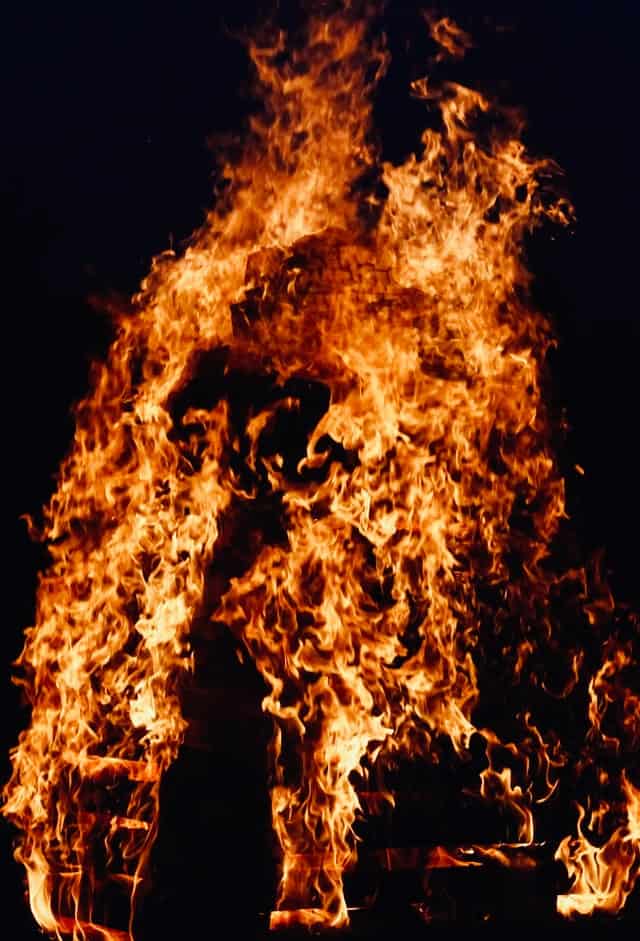The joke that was already decades old by the time I hit my early camping years in the late 1980s/early 1990s was when it doubt, use “Scout Water” to get that fire going. Scout Water was, of course, gasoline, and yeah, that’s one way to start a bon fire. But is it really a safe way to start a fire?
In a simple one word answer: NO!
It is never safe to start a fire with gasoline and you should never pour gasoline onto an already lit fire. In fact, safety guides for fire departments, work safety organizations, and others will straight out tell you it is never safe to start a fire with gas. Gasoline was not created for starting fires and should not be used that way.
Don’t believe me? Here’s a short video of one idiot blowing himself up because he used gasoline to start a bonfire.
Gasoline Wasn’t Made for Starting Fires
There’s also the famous video of someone throwing live gas on a fire, the fire jumping up the stream of gas back to the can and following him around creating a massive trail of fire as he tries to outrun the newly formed fire trying to go all the way back into the gas can.
In fact, this is such a serious issue that the government of the state of Oregon released a safety document attempting to educate the public on fire safety.
Keep in mind that just because something can react and start a fire doesn’t mean it should. Gasoline was not made as a fire starter. While it has been use in improvisational fashion for this, including with the famous Molotov Cocktail, that should only underline how dangerous the combination of gas and fire can be.
Gasoline should never be used as a fire starter. Gasoline should never be used to accelerate or feed a fire, as well. Under know conditions is this safe.
Precautions can be taken to make it less dangerous, but using gas around fire is always going to be extremely dangerous and in the wrong situations can even be fatal.

Gasoline Vapors Are Flammable
The problem is the number of people who watch movies or TV for their info, or just simply assume they know what they’re doing. Gasoline is made as a fuel – not as a fire starter.
The gasoline itself isn’t the only thing that’s flammable. The vapors that come off the gasoline are also flammable. The more an area is soaked, the more seconds that pass to allow the vapors to get in the air, the more dangerous the area is.
This is how there are so many videos where a fire seems to start many feet away from the burn pile or the air itself seems to ignite in a large area. Because it actually does.
Another “lucky to be alive” videos of why gasoline and bon fires don’t match, this one courtesy of an insurance company:
Why Did That Gasoline Explosion Look So Weird?
No, these videos don’t go through editing or anything weird. Vapors are heavier than air. This means wind doesn’t move them as much as you might think unless it’s a very strong wind, and the vapors are going to gather around the ground and spread outward from where the gas was poured.
This creates an invisible circle. You could be ten, fifteen, even twenty feet away and if enough gas was put on a pile, lighting a match that far away could still result in an explosion of flames.
Thing of it as a thick, invisible, heavy mist along the ground. Anyone who has lived in the country and in climates with foggy days have seen those mornings where the mist hugs the ground. Now imagine all of that is flammable.
This is also a major reason why gasoline and fire don’t mix. You can’t see where all the fumes have spread, and how much of the actual air is flammable at that point.
Always Use Caution with Gas
This includes proper ventilation in any area. Gas cans need to be properly secured, areas where a gas can was open or funnel used still needs to be ventilated.
Gasoline is not a substitute for charcoal, natural fire starters, or even lighter fluid. Lighter fluid is actually designed for use with lighting fires and that’s why it’s designed to be used this way. That can be safe when all instructions are followed.
But lighter fluid and gasoline are NOT the same things.
Don’t assume you can just substitute one for the other. That’s just asking for a really bad time. The average cost for a hospital visit for burns in the United States is $24,000 according to Research America, so save yourself the bills, the raised premiums, and the hassle.
Don’t Use Gasoline for Fire
Gasoline is not a safe way to start a bonfire. Yes, there are individuals who have done this successfully. There are people who have soaked wood in gas used for a bonfire. That doesn’t make it a good idea.
Using gas to start a fire is dangerous. Tossing gas onto a fire that’s already burning is not only dangerous but quite stupid, as well. Not to mention the fact that any fire you add gas to is not one you want to cook over.
There are plenty of ways to start even giant bonfires for rubbish and trash using conventional methods. In Scouts we used dried rolled newspaper dipped in wax, dried, and with a bit of twine. That small fire starter would burn for a good five minutes.
Add a small cup of sawdust, dried birch bark, or just some tried thin twigs underneath and the fire will spread and grow.
Without the danger of blowing yourself up and sending yourself to the emergency room with permanent burn injuries.
Be safe and smart. Don’t use gasoline to start, feed, or be anywhere near a fire.
Resources
